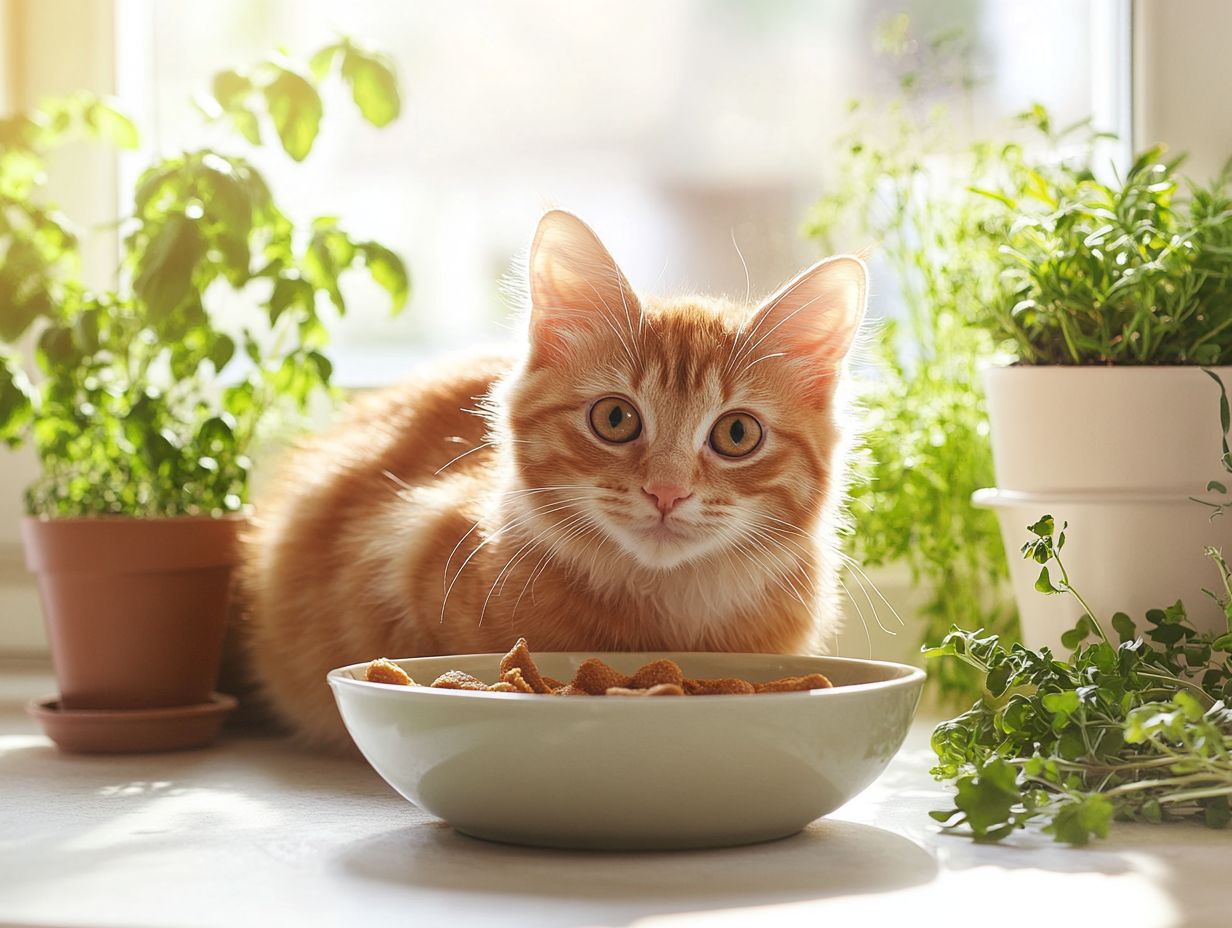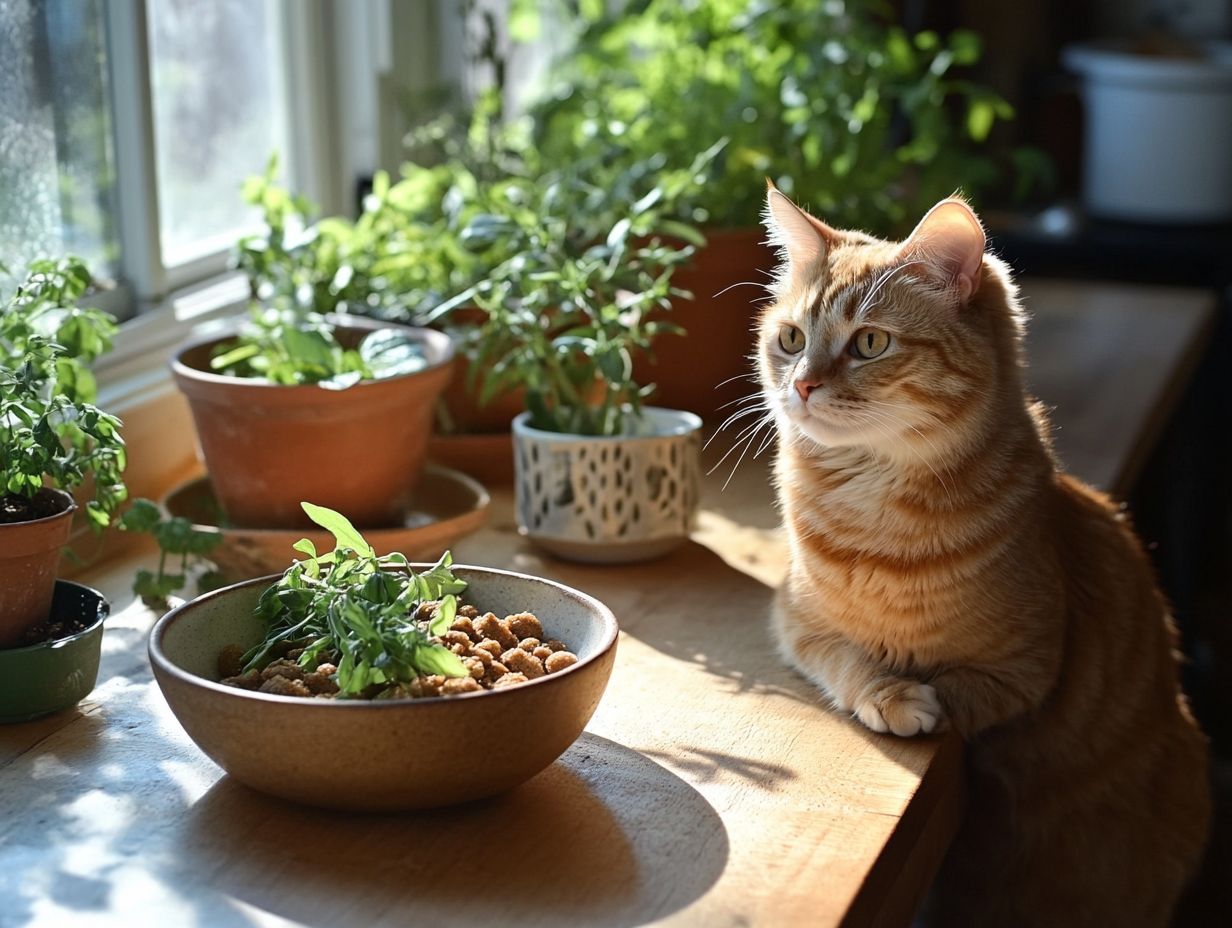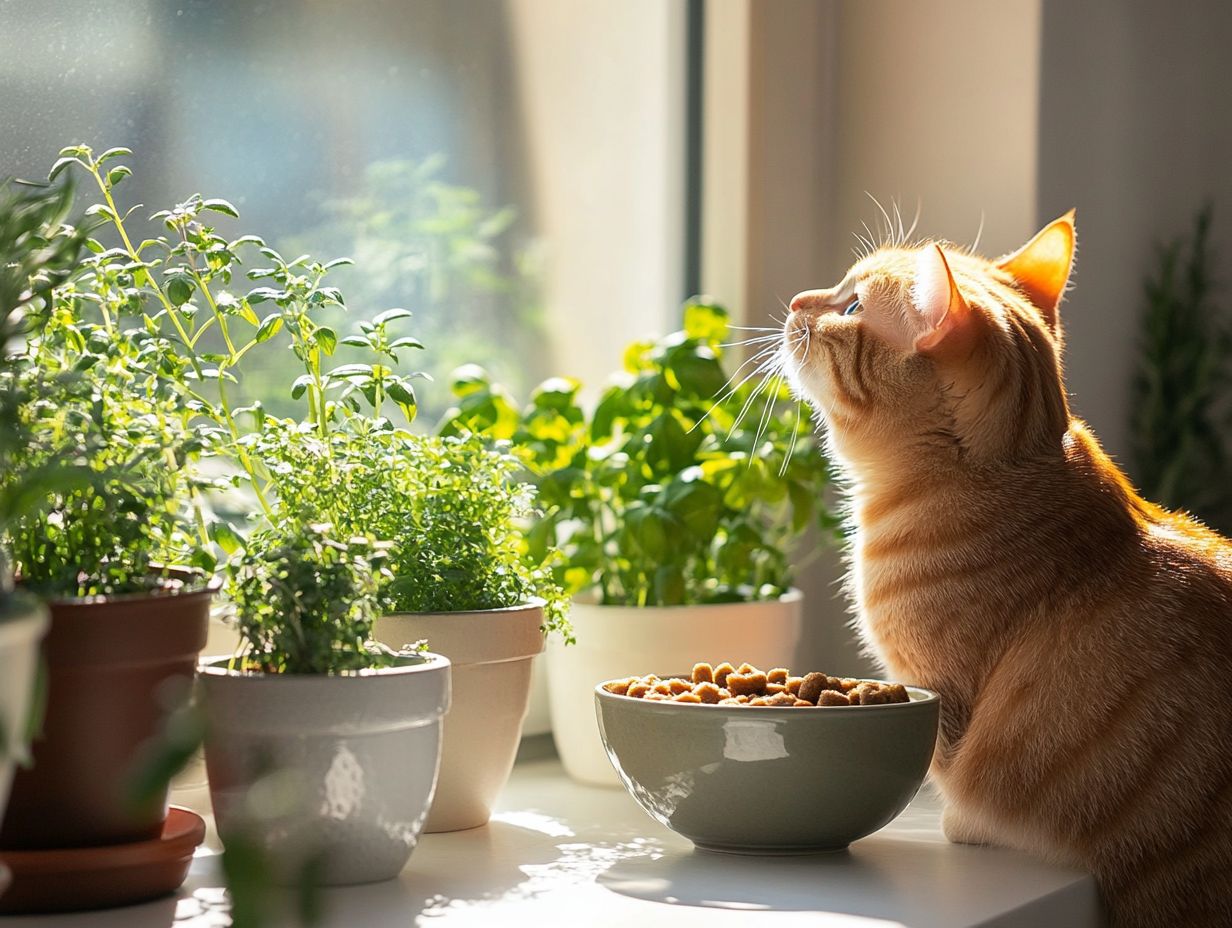When it comes to your feline friend’s diet, it’s essential to remember that cats are obligate carnivores. While organic options are appealing, the primary focus should be on high-quality animal-source proteins that are essential for their health and well-being. It is advisable to consult with a veterinary professional when choosing cat food, as organic does not always equate to better nutrition.
USDA Certified Organic Cat Food stands out for its promise of animal-source proteins and essential nutrients, as well as strict production standards, meeting the USDA organic standards.
This article explores what makes cat food USDA certified organic, the benefits it offers, and the specific requirements and regulations involved, including the AAFCO definition and pet food regulations. We will also discuss potential risks of organic diets, such as the lack of certain nutrients found in animal products, especially in vegan options, helping you make an informed choice for your beloved pet.
Key differences between organic and non-organic options will also be highlighted, ensuring you consider your cat’s unique dietary requirements.
Key Takeaways:

What is USDA Certified Organic Cat Food?
USDA Certified Organic Cat Food is pet food that adheres to strict organic farming standards set by the USDA, ensuring that its ingredients come from farms that do not utilize synthetic fertilizers, antibiotics, growth hormones, or pesticides. This certification confirms that the cat food contains organic ingredients meeting the AAFCO definitions, thereby guaranteeing both quality and safety for our cats.
Why Choose USDA Certified Organic Cat Food?
USDA Certified Organic Cat Food offers several benefits, including high nutritional value, enhanced safety, and various health advantages. These foods are made exclusively with ingredients that have certified organic status and comply with stringent safety regulations. While organic foods may reduce the risk of certain allergies, they still need to meet the feline nutritional profile, which should include animal proteins.
What Are the Benefits of Organic Cat Food?
The benefits of organic cat food include enhanced nutrition, safety from harmful additives, and improved palatability.
Organic cat foods generally have better digestibility due to the higher quality of ingredients, allowing cats to absorb more nutrients from their meals. There is also a reduced risk of allergies associated with organic foods, as they lack artificial preservatives and fillers that can be tough on sensitive stomachs. However, it’s crucial that these foods still meet the necessary nutritional requirements for felines.
Cailin Heinze, a veterinary nutritionist at Tufts University’s Cummings School of Veterinary Medicine, states that adhering to strict organic standards ensures that harmful additives are excluded from the food and promotes sustainable farming practices. This provides pet owners with reassurance that they are making a choice that benefits both their cats and the environment.
What Are the Requirements for USDA Certified Organic Cat Food?
USDA Certified Organic Cat Food must comply with the standards set by both the USDA and AAFCO. These standards require sourcing certified organic ingredients, following organic farming practices, and ensuring that the final product is free from synthetic substances and harmful additives.
What Ingredients are Allowed in Organic Cat Food?

Organic cat food is made with a variety of certified organic ingredients, including proteins, grains, and vegetables, all sourced from producers who adhere to the USDA’s stringent organic agriculture standards.
- Organic Proteins: Chicken and fish are among the most common proteins found in organic cat food, as they supply the essential amino acids necessary for a cat’s health.
- Organic Grains: Wholesome grains such as brown rice and oats are frequently included to provide fiber and energy.
- Organic Vegetables: Fresh vegetables like peas and carrots contribute vital vitamins and minerals.
By sourcing these ingredients from recognized organic producers, the quality of the food is ensured, while also supporting sustainable agricultural practices that benefit the environment.
What Ingredients are Prohibited in Organic Cat Food?
It’s essential to avoid ingredients that are toxic to cats, such as onions, garlic, and chocolate, ensuring the safety of your pet’s diet. The best practices for food storage and handling should also be followed, including recognizing spoilage signs to maintain quality.
Special Dietary Needs for Various Life Stages
It’s important to address the unique nutritional requirements of cats at different life stages. Kittens, senior cats, and pregnant or nursing cats have specific dietary needs that should be met to support their health and development.
In conclusion, always remember that the health and nutritional needs of cats must come first in any dietary consideration, regardless of ethical or sustainability concerns.
Prohibited ingredients in organic cat food include non-nutritive synthetic substances, antibiotics, growth hormones, and pesticides. These restrictions are essential to ensure that the food is free from harmful additives that could compromise pet health. While organic standards prohibit certain additives, they do not guarantee the absence of allergens or harmful ingredients specific to individual cats.
By preventing the introduction of potentially toxic elements into a cat’s diet, these regulations play a crucial role. For example, the presence of non-nutritive synthetic preservatives or flavor enhancers can lead to long-term health issues, such as allergies or gastrointestinal disturbances. It’s important to note that these issues can arise from a variety of dietary factors, not solely from the presence of certain additives. Additionally, harmful additives like artificial colors have been linked to behavioral problems in pets.
By adhering to organic standards, manufacturers not only support animal well-being but also promote sustainability, aligning with the growing trend among conscientious pet owners who prioritize cleanliness and purity in their pets’ nutrition. Before switching to organic cat food, especially for cats with specific health conditions, it is advisable to consult with a veterinarian.
How is USDA Certified Organic Cat Food Regulated?
USDA Certified Organic Cat Food is regulated by the National Organic Program (NOP) of the USDA, which enforces strict guidelines that producers must adhere to in order to comply with organic standards. This ensures that the pet food is both safe and healthy. Additionally, organic foods still must meet AAFCO nutritional guidelines for completeness and balance.
What Are the Standards for Organic Cat Food Production?
The USDA establishes the standards for organic cat food production, which include organic farming practices that prohibit the use of synthetic fertilizers, growth hormones, and pesticides to maintain the organic seal. These stringent guidelines require that all ingredients be sourced from certified organic farms that prioritize soil health and biodiversity.
Additionally, organic handling mandates that organic materials be kept physically separated from non-organic materials during storage and transport to prevent cross-contamination. Proper food storage and handling for organic cat food are crucial to prevent spoilage and maintain quality. Processing facilities must ensure that equipment and surfaces are meticulously cleaned to eliminate any risk of non-organic ingredients coming into contact with organic materials. Adhering to these standards protects the integrity of the product and promotes sustainable agricultural practices.
How Are Organic Cat Food Producers Certified?
Producers of organic cat food undergo a rigorous certification process to ensure compliance with USDA organic standards. This process involves thorough documentation and periodic inspections by accredited certifying agents and includes third-party audits to ensure compliance and quality. It guarantees that producers not only source organic ingredients but also adhere to established manufacturing practices.
Initially, producers must apply and submit a detailed description of their practices, which includes ingredient sourcing and product formulations. Following this, an inspection is conducted to thoroughly review the facilities, records, and production processes.
Ongoing compliance is mandatory; producers must undergo regular inspections and report any significant changes in their production practices or inputs. While organic certification is essential, organizations such as AAFCO play an equally important role in setting nutritional standards, ensuring that these products not only meet organic requirements but also provide balanced nutrition for cats. The importance of animal-source proteins in the diet of obligate carnivores cannot be understated, linking back to the essence of feline nutrition.
What Are the Differences Between Organic and Non-Organic Cat Food?

The differences between organic and non-organic cat food are considerable, especially regarding ingredient quality, nutritional value, and the presence of non-nutritive synthetic substances, all of which can impact a cat’s overall health and well-being.
What Are the Differences in Ingredients?
The primary differences in ingredients between organic and non-organic cat food stem from their sourcing methods. Organic cat food utilizes certified organic ingredients that are free from pesticides and synthetic additives. This distinction is significant, as many pet owners aspire to provide their pets with the healthiest diet possible, though this term is subjective and varies based on individual cat needs.
Organic cat food often features higher-quality proteins, such as cage-free chicken or grass-fed beef, which offer more nutrients and promote better ethical practices. In contrast, non-organic options may source ingredients from industrial farms that use antibiotics and hormones, which can end up in the food you serve your cat.
Both organic and non-organic cat food may contain grains like rice or corn; however, organic varieties will exclusively include grains that are sourced in a manner that adheres to organic agricultural practices. This can enhance the overall quality of the food, reflecting a growing trend among responsible pet owners.
What Are the Differences in Production Methods?
The production methods for organic cat food are notably different from those of non-organic food, primarily because they adhere to organic standards that prohibit the use of fertilizers, growth hormones, pesticides, synthetic substances. This commitment to organic practices ensures that the ingredients are cultivated in a way that promotes ecological balance, which helps preserve the nutrient density essential for pet health.
For instance, while non-organic producers may rely on chemical interventions and synthetic fertilizers to boost yields, organic farms prioritize maintaining soil health through practices such as crop rotation and natural pest management. These differences significantly impact not only the nutritional profile of the food but also its long-term safety for pets, aligning with USDA organic standards.
The USDA has established strict regulations governing organic labeling, requiring that up to 95% of the ingredients in organic cat food come from certified organic sources. This aligns with USDA National Organic Program standards, enhancing consumer trust in the products they select for their furry companions.
How to Choose the Right USDA Certified Organic Cat Food for Your Pet?
When selecting USDA Certified Organic Cat Food, it is essential to consider the ingredients list, nutritional value, and brand reputation to ensure you are choosing a quality product that adheres to organic standards. It is advisable to consult with a veterinarian before making any dietary changes for your pet, especially when transitioning to organic foods.
What to Look for in the Ingredients List?
When examining the ingredients list for organic cat food, it is important to look for several key factors. Firstly, ensure that the food contains certified organic ingredients and organic ingredients, along with a clear breakdown of protein, fat, fiber, and water content, while also being free of synthetic substances.
Next, closely examine the specific types of protein sources included. High-quality animal proteins, such as chicken, turkey, or fish, are essential, as they provide the necessary amino acids for a cat’s overall health, adhering to AAFCO definition standards. Cats are obligate carnivores and require a diet primarily made up of animal proteins.
Additionally, verify the presence of reputable organic certifications, including the organic seal. These certifications are crucial for consumers seeking organic cat food brands, as they guarantee the absence of harmful pesticides, antibiotics, and growth hormones and confirm that ethical sourcing practices have been followed.
Lastly, consider the nutritional composition. Healthy fats and an appropriate amount of fiber are vital for a cat’s digestive system and energy levels. Avoid excessive carbohydrates in the diet since cats have low carbohydrate requirements. It is also crucial to consider the absence of animal byproducts and review the proportions of fat and fiber listed in the ingredients.
What to Consider When Choosing a Brand?

When selecting a brand of USDA Certified Organic Cat Food, it is important to consider several factors, including the brand’s reputation, commitment to quality, adherence to organic standards, and feedback from other customers. Consulting with a veterinary nutritionist can also help ensure that you make a safe and nutritious choice for your pet.
Transparency regarding sourcing and production methods is also crucial; brands with clear supply chains demonstrate a commitment to ethical practices and align with human food standards. Customer reviews can provide valuable insights into the benefits experienced by other pet owners, so look for reviews that highlight specific advantages, such as improved health or digestion.
Frequently Asked Questions
What does it mean for cat food to be USDA Certified Organic?
USDA Certified Organic cat food must meet specific regulations set by the USDA, ensuring it is free from harmful substances and produced using organic methods.
Are there any risks associated with organic cat food?
While organic cat food can offer benefits, it may not always meet all of a cat’s nutritional requirements. Always ensure the diet adheres to AAFCO standards for balanced nutrition.
What about supplements in organic cat diets?
Consult with a veterinarian about the safety and necessity of supplements in organic cat diets, including appropriate dosages based on your pet’s specific needs.
How should organic cat food be stored?
Proper storage practices for organic cat food include keeping it in a cool, dry place and ensuring that the packaging is sealed to maintain freshness and prevent contamination.
When a cat food is labeled as USDA Certified Organic, it means that it has met strict guidelines set by the United States Department of Agriculture (USDA) and the USDA National Organic Program (NOP) for organic products. This includes being made with ingredients that are grown and processed without the use of synthetic pesticides, fertilizers, or genetically modified organisms (GMOs).
Is USDA Certified Organic cat food better for my pet?
USDA Certified Organic cat food may offer benefits, but it is essential to consult with your veterinarian to ensure it meets your cat’s specific dietary needs. It is produced under guidelines that minimize the use of synthetic pesticides, fertilizers, and GMOs, but this does not guarantee the absence of all harmful substances.
What are the benefits of feeding my cat USDA Certified Organic cat food?
Feeding your cat USDA Certified Organic cat food can have several benefits. While organic ingredients may be of higher quality, it is crucial to ensure that the diet meets the specific nutritional requirements of cats as obligate carnivores. Otherwise, there is a risk of potential nutritional deficiencies. It can contribute to their overall health, provided it meets their nutritional needs, and reduce their exposure to potentially harmful chemicals and additives, similar to natural cat food.
Can I trust that a cat food labeled as USDA Certified Organic is truly organic?
Yes, you can trust that a cat food labeled as USDA Certified Organic is truly organic. The USDA and AAFCO have strict guidelines and regulations in place to ensure that products with this label meet their standards. However, it is important to verify specific product formulations against AAFCO standards and consult with a veterinarian due to the complexity of feline dietary needs. Additionally, these products are regularly inspected and certified by third-party organizations.
Does USDA Certified Organic cat food cost more than regular cat food?
Yes, USDA Certified Organic cat food may cost more than regular cat food. This is because the production process for organic products involves more labor and resources, and the ingredients used are typically of higher quality, similar to human food production. However, it’s important to evaluate the nutritional profile and ingredient sourcing rather than solely focusing on price, as a higher cost does not always correlate with higher nutritional quality. The benefits for your pet’s health may outweigh the added cost.
Is USDA Certified Organic cat food suitable for all cats?
While USDA Certified Organic cat food can be suitable for many cats, it is crucial to consider individual health needs and consult with a veterinarian, especially for cats with health conditions or specific dietary requirements. Some cats may have dietary restrictions or health conditions that require specific types of food, so it’s important to consider these factors before switching to organic cat food, as guided by pet food regulations.
Proper Food Storage and Handling
To ensure the safety and quality of your cat’s food, it is important to follow proper storage and handling practices. Store cat food in a cool, dry place and seal it tightly to prevent spoilage. Check for signs of spoilage, such as an off smell or unusual texture, and adhere to feeding guidelines to prevent health issues.
Ethical Considerations
Feeding organic diets may also reflect ethical considerations regarding animal welfare and environmental impact. However, the primary focus should always be on your cat’s health and nutritional needs when selecting their diet.